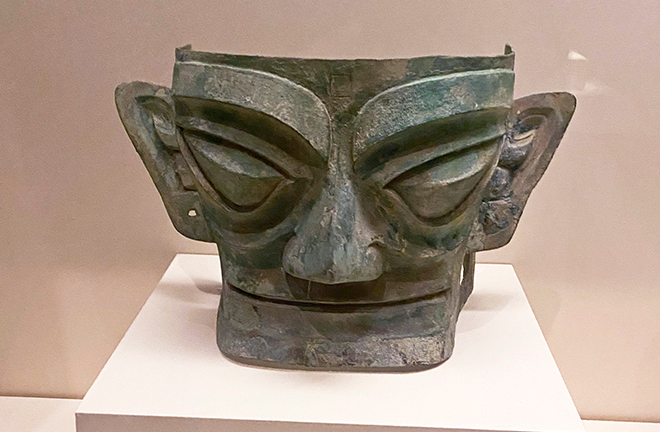Scholars call for problem-solving historical research

A “bronze mask” unearthed in the Sanxingdui site at the National Museum of China, in Beijing Photo: Chen Mirong/CSST
XI’AN—Scholars called on historical research’s academic norms to consciously strengthen the discipline’s problem-oriented awareness at a recent seminar held in Xi’an City, Shaanxi Province.
Problem-solving awareness
For nearly half a century, some Chinese historiography scholars have tasked themselves with introducing Western academic thoughts and disseminating modern scientific thoughts, thus forming research and publication patterns that follow a relatively complete theory or concept and narrate its generation and evolution.
However, the ultimate goal of research is to add new knowledge, not to simply reorganize old knowledge. According to Qu Anjing, director of the Institute for Advanced Studies in History of Science at Northwest University, for many years some historical research has been satisfied with simply interpreting a story, which has obscured the essential difference between historical narratives and “historical research.” This phenomenon misleads scholars, causing them to deviate from scientific research tracks centered on “problem-solving.”
In Qu’s view, problem-solving is the sole criterion for measuring academic research. Therefore, academic papers must be professional and readable. They do not have to tell a complete story, but they must solve at least one real academic problem.
Highlighting the “problem domain” of historical research does not mean abolishing the tradition of storytelling, said Wang Jianxin, a professor from the School of Cultural Heritage at Northwest University. Archaeological research has formed a tradition of storytelling which incorporates an empiricist thought process. To raise the problem awareness of archaeological research, we need to lay equal emphasis on “storytelling” and “problem domains,” conducting problem-oriented research and exploring theoretical methods on the basis of good storytelling.
Take the archaeological study of the ancient Yuezhi culture as an example. On the one hand, there were narrative records of the Yuezhi culture in Shiji (Records of the Historian), Hanshu (History of the Former Han Dynasty), Houhanshu (History of the Later Han Dynasty), and later archaeological documents. On the other hand, Wang said that when researching specific issues such as the exact location of the site between Dunhuang and Qilian, an area the Yuezhi people once resided as recorded in historical literature, we should use innovative archaeological theories and methods developed to track nomadic settlements.
Offering wisdom
Guo Lihong, president of Northwest University, said that China has passed on a good tradition of respecting history, studying history, researching history, and applying history. Currently, it is more urgent to reinforce historical research and grasp historical development’s law in dynasties’ rise and fall, against the backdrop of realizing the Chinese nation’s great rejuvenation and against great changes unseen in the world in a century.
A major mission of historical research is to explore the internal logic and law of social changes, providing references for the development of civilization. Since the 1920s, Chinese archaeology has established a relatively complete set of theories and methods, with many major archaeological discoveries constantly refreshing people’s understanding of Chinese history. In the development process of the Chinese nation’s pluralistic integration, the vast array of historical classics has allowed for great development of Chinese historiography, while new archaeological discoveries have further broadened the horizon and patterns of historical research, said Wei Jian, a professor from the Institute of Northern Ethnic Archaeology at Renmin University of China.
Modern humanities
Shen Weirong, a professor from the School of Humanities at Tsinghua University, pointed out that the establishment of modern humanities is marked by “historical and philological studies” of spiritual civilization and culture, which are distinguished from traditional “philosophical and theological studies.” As historiography and philology represent science and rationality, humanities research can only be scientific and academic. Generally, philology refers to all the knowledge, learning, and scholarship related to language and text in the world, and it is modern humanities research’s forgotten source. To step out of the historical research crisis, we must return to philological studies.
Guan Zengjian, a professor from the School of History and Culture of Science at Shanghai Jiao Tong University, explained the three tiers of historical research: one is to restore history by collecting data and sorting out historical facts; the second is to interpret history by clarifying the causality and motivation of historical development; the third is to gain enlightenment from the past and then apply history.
Guan used Newtonian mechanics and Albert Einstein’s theory of relativity as examples to illustrate that the study of science history should clarify the difference between historical science and modern science.
Edited by YANG LANLAN
